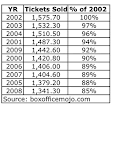I have been an avid film buff since my Mom took me to see Anchors Aweigh in 1945. Though I liked James Cameron’s Terminator 2, one Alien was more than enough for me and I could not bring myself to see Titanic. Cameron, in my book, did not belong in the same league as Lean, Ford, Hawks, Lubitsch, Capra, Wilder, Spielberg, Cukor, Hitchcock, Coppola, Scorsese et al.
But, on Christmas Eve I went to see Cameron’s latest, Avatar, a 3D film, in all of its glory on an IMAC screen. I went despite my opinion of Cameron as a film-maker/director because I have been reading that the latest 3D technology would be the savior of movie theaters against the growing trend for people to watch films on their home TV screens, laptop computers and even small mobile devices such as iPods. I was particularly interested in how the 3D technology might impact on downtown movie theaters, many of which are relatively small, with fewer screens and less able to support badly needed investments. The primary question I brought to my viewing of Avatar was: Could the 3D technology produce a movie experience that was so unique that it could draw people off their couches or away from their handheld devices and back to movie theaters – especially those in downtowns?
Avatar plain blew me away! It is a watershed in movie-making and one of the most impressive films I’ve seen since Lawrence of Arabia. Watching it you keep asking yourself what kind of mind conjured this reality up and what technologies are putting it on the screen so realistically and so competently? Your immersion into a totally strange, yet coherent, detailed and comprehensive new world is staggering – so much so, that the storyline, which is too often hokey and filled with 60’s political stances, seems acceptable. I intend to see Avatar on a regular 3D screen to determine how much of this impact was due to the huge IMAC screen and the immersive experience it supports, though published film reviews also report about the strong, unique viewing experience Avatar generates on normal 3D screens.
Avatar definitely created a type of experience that I would abandon my easy chair and ignore the four full length films on my iTouch to enjoy again in other movies shown at my local cinema.
However, this experience may be due as much or more to computer-generated, special effects that are not 3D related. For example, the Na’vi, a humanoid race at the core of the film, are completely realistic, with little evidence of contrivance. The biggest grossing movies for the last 10 years (Transformers 2, The Dark Knight, Spider-Man 3, Dead Man’s Chest, Revenge of the Sith, Shrek 2, Return of the King, Spider-Man, Harry Potter / Sorcerer’s Stone, The Grinch) all were either heavy on computer generated special effects or computer animated. These movies are costly and studios are making about 15% fewer films than last year, probably as a result.

The studios’ emphasis on big budget, high tech films that are sequels or remakes increased attendance at movie theaters in 2009 by close to 8%, according to data published by boxofficemojo.com. With recession restrained ticket prices remaining steady, box office receipts increased by about the same magnitude as attendance. That would place 2009 as the fifth highest in attendance over the past 10 years, still 8% less than the peak in 2002.
It appears that evidence is starting to accumulate indicating that downtown theaters that can show films using 3D and other digital special effects technologies will be able to compete with home theaters and personal film viewers such as the iTouch and iPhone.
But, I doubt that 3D or other digital special effects can be used to enhance the viewing experience for movies such as Casablanca, The Maltese Falcon, On The Waterfront, A Streetcar Named Desire, Annie Hall, The Godfather or the vast majority of lower budget films such as Juno, Education and It’s Complicated, that have recently been turned out by independent production companies. The “indy” films have been a source of strength to some of the most successful movie theaters in large urban neighborhoods and medium-sized downtowns. The audiences at these often packed theaters are overwhelmingly composed of the almost 25 million Americans aged 55 or more who go to the movies every year.
But, the competition is also getting stronger. High tech innovations are also increasing the lure of home entertainment equipment. Tim Bajarin, of Creative Strategies, who I think is the best in the business on computer related markets, sees 3D television taking hold soon, while DVDs rapidly are being displaced by on-demand streaming of movies. (See: PC Mag Article Here).
Consequently, I think that downtown cinemas need to not only be capable of digital projection and showing 3D films, but they also need to:
- Make watching a movie with others in an audience a very pleasurable and therefore desirable experience. This not only means clean and comfortable seats, clean floors, good sound equipment, etc., but the enforcement of rules that are absolutely intolerant of patrons acting without civility to those around them
- Integrate the movie-going with unique eating and drinking opportunities such as a quality restaurant, a coffeehouse, a first-rate ice cream parlor or a brew pub
- Court and pamper the 55 year old + audience. It has accelerating growth.
N. David Milder